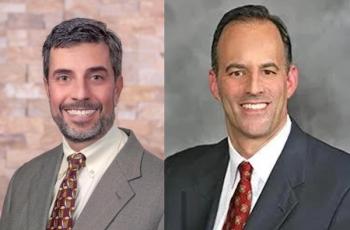
Doctors should cooperate, not compete, with retail clinics
Despite concerns, primary care doctors see a role for clinics as partners in improving communication and care coordination.
Physician organizations including the American College of Physicians (ACP) and the American Academy of Family Physicians (AAFP) have come out in favor of retail clinics as partners in a medical neighborhood that includes primary care, post-acute care, and community and social services.
“We recognize that our patients love the convenience of these clinics and that we as physicians must be able to work collaboratively with them,” says Wayne Riley, MD, MPH, MBA, a general internist and president of the ACP. “They are appropriate for minor episodic illnesses but do not supplant having a relationship with a primary care provider.”
The number of clinics in the U.S. will almost double between 2014 and 2017 to 2,800, according to a recent report by the Chicago-based management consulting firm Accenture, as the clinics offer more services, invest in technology, and forge alliances with providers. At the same time, evidence suggests that the quality of care provided in clinics can be as good or better than in other settings-at much lower cost.
Studies indicate that clinics lead to overall cost savings by offering patients an alternative being treated in an emergency department. That adds up to savings of approximately $4.4 billion annually, according to the April 2015 report, “Building a Culture of Health: The Value Proposition of Retail Clinics,” commissioned by the Robert Wood Johnson Foundation.
Retail clinics can be part of a larger strategy to improve access to primary care in light of a looming shortage of providers, says Riley, a clinical professor of medicine at Vanderbilt University School of Medicine in Nashville. The clinics also can help drive business to existing primary care offices through referrals and encourage patients to seek out medical homes.
“Partnering with clinics is the best strategy and we are advising physicians to establish relationships with clinics in their communities,” says Riley. “Anything we can do to encourage patients to establish relationships with primary care physicians is in the best interests of the entire healthcare system.”
While large chains are taking steps to strengthen their collaboration with physicians, communication between clinics and physician offices remains inconsistent and many physicians remain wary of clinics’ foray into chronic care.
“Ideally, the clinics would encourage patients to follow up with their primary care physician and make every effort to transfer their records in a timely way, but frequently that communication doesn’t happen,” says John Meigs, Jr., MD, a family physician in Centreville, Alabama, and president-elect of the AAFP. “The clinics can’t substitute for a long-term relationship with a primary care provider who recognizes changes in a patient’s condition and works on risk factors and preventive measures to keep them healthy.”
Physician concerns
Major players in the retail clinic market, including Walgreens, Walmart, and CVS Health’s MinuteClinics, recently began offering various levels of chronic disease management services in addition to the traditional menu of services for acute, episodic illnesses, and immunizations. Some physicians view this as a dangerous trend, especially since most clinics are staffed by nurse practitioners and physician assistants rather than physicians.
While not opposing the move, medical societies are adamant that clinics maintain a niche role in chronic care and recognize that their goal should be guiding patients toward primary care homes. The American Academy of Pediatrics, for example, updated its policy on retail clinics in 2014, stating its continued opposition to the outlets as a source of primary care for children unless they enter into partnerships with physicians.
The ACP has also recently expressed concerns about clinics’ expanding scope of services and outlined what it views as the appropriate role for clinics in the healthcare delivery system. The clinics are a convenient alternative for some patients without serious illnesses, the authors state, but are not recommended for all patients.
“If you’re relatively healthy and have a minor illness such as sore throat or you need an immunization, it’s perfectly appropriate to visit a retail clinic,” the ACP’s Riley says. “But the providers at these clinics are not trained to take care of patients with complex or multiple problems, such as heart disease or chronic obstructive pulmonary disease, or those who have had stroke.”
Clinic staff may get a snapshot of a patient on the day of their visit but often lack crucial details about underlying conditions, says the AAFP’s Meigs. That can lead to misinterpreting symptoms and overprescribing antibiotics.
“I have a patient who frequently shows up saying she has a sinus infection, but I know that she has a history of lung issues and may have to go on a ventilator later that day,” he says. “The clinic may be treating her symptoms according to evidence-based protocols but a patient’s chief complaint is not always the real issue.”
Patients with underlying chronic conditions should not seek any type of care at retail clinics without first consulting with their regular physician, he maintains. “Patients don’t always understand the complexity of what they have and fail to share important information with the clinic providers,” says Meigs. “If someone’s diabetes is not well controlled, for example, a minor infection can become a serious life-threatening illness in a very short time.”
There is an inherent danger in treating patients according to disease protocols without knowing the context of their medical history, agrees Wanda Filer, MD, MBA, a family physician in York, Pennsylvania, and president of the AAFP.
Filer cites the example of one of her patients who visited a retail clinic and was diagnosed and treated for a urinary tract infection based on symptoms of abdominal pain and abnormal urine test results. The next day she felt worse and called Filer, who discovered that her urine was abnormal for bilirubin and ordered immediate gallbladder surgery.
“Even if this patient had a UTI, I might know that she’s had several UTIs and look at the underlying causes,” says Filer. “That’s where continuity with a primary care provider is really important because we have that longer view focused on the long-term wellness of the patient.”
Filer and others also worry about sporadic communication between clinics and physicians regarding the details of patients’ visits. Filer specifically has concerns about patients visiting different clinics, resulting in records rarely getting to her office, creating “critical gaps in communication,” especially with her more vulnerable patients.
Anthony Hilliard, MD, a cardiologist at Loma Linda University Medical Center in California and chair of the American College of Cardiology’s early career council, says he is not routinely notified when one of his patients visits a clinic. That could lead to life-threatening consequences because of potential medication interactions with prescribed antibiotics, he notes.
“If a patient is on an antiplatelet drug because they have a coronary stent and they go to acute clinic for a nosebleed, I don’t have any assurance that a phone call will be made so I can explain the need for continuing that medication,” he says. “There are certain antibiotics that can’t be prescribed to patients who are taking anti-arrhythmic drugs.”
However, since retail clinics are a growing presence in the market, physicians need to find ways to work with them for the benefit of patients, the physicians say. They recommend that doctors develop working relationships with the major retail clinics in their area and establish reliable channels of communication.
“Clinics can be part of the medical neighborhood if they have a medical director in the community to direct care and coordinate with local providers,” says Meigs, adding that clinics should at least try to fax records to medical practices and advise patients to return to their primary care provider for follow-up.
It’s also crucial to educate patients about retail clinics and to emphasize the coordinating role of the primary care provider, says Filer.
“Patients tell me that they’ve been to a clinic several times since their last visit and they often aren’t aware that I don’t know about it,” says Filer. Although some clinics routinely forward records of patient visits to their physicians, patients should be advised to ask specifically about it during a clinic visit, she says.
Instead of seeing retail clinics as competitors, physicians can acknowledge that they have a legitimate role to play in a patient’s care and discuss when it may or may not be appropriate to use them, says Hilliard.
“Clinics sometimes could be a good access point as opposed to urgent care where they might have a longer wait time,” he says. “There is a niche role for the retail clinic in the acute illness setting or when patients are traveling outside their home area.”
‘Part of the solution’
Notwithstanding those concerns, the ACP and AAFP have acknowledged that retail clinics can play an important role in improving care for chronic diseases-if they work collaboratively with physicians.
In November 2015, the Health is Primary campaign, a coalition of family medicine practices led by the AAFP, joined with CVS Health’s MinuteClinics in an educational campaign aimed at getting that message out to consumers. MinuteClinics-the largest player in the retail clinic market with more than 1,100 locations nationwide-has forged partnerships with more than 60 health systems to ease communication and data sharing between its clinics and physician offices.
Under a typical agreement, MinuteClinic staff members are assigned local supervising physicians in the partnering health system to consult on cases as needed, while compatible electronic health record (EHR) systems facilitate automatic transfer of patient records between clinic and physician office. The clinics fax visit summaries every 24 hours to physicians outside of the health system, and refer patients who do not have primary care relationships to local physicians who are accepting new patients.
“We have an obligation to the community to be part of the solution for healthcare in general,” says Nancy Gagliano, MD, senior vice president of CVS Health and chief medical officer of MinuteClinic. “Therefore our role is much bigger than taking care of that sore throat-it’s also making sure patients are connected to healthcare so their chronic conditions are taken care of.”
MinuteClinic has protocols in place to encourage patients with more serious health issues to seek follow-up care with a physician, she says. An internal chart review team monitors visit summaries to ensure that clinic staff are documenting chronic diseases, like high blood pressure.
Clinic staff members also urge patients to see a physician if they have visited a clinic more than three times in the same year for a recurrent condition that may signal a more serious underlying disease.
Monitoring patients for recurrent infections and sending them to a physician is critical, notes Filer. If a patient has had three UTIs or strep throats in the last six months, for example, a physician might order a blood test to rule out pre-leukemia or consider a tonsillectomy rather than continue to prescribe antibiotics.
Another potentially concerning scenario is that of a patient who repeatedly visits retail clinics for symptoms of what he or she believes to be a head or chest cold but is more likely asthma, she says. The underlying condition may go undiagnosed in a clinic, but a physician is trained to notice nuances in a patient’s breathing and ask about family history and environmental triggers, such as pet allergies.
“When I see a patient who has been to a clinic, I start from square one,” says Filer. “I always take a fresh history and look at their past records before making my own diagnosis.”
Moving forward
Whatever the concerns about retail clinics, they are likely to continue growing in response to consumer demand. Most clinics now accept commercial and government insurance and offer more convenient access and longer hours than other settings of care.
It makes sense to leverage the “astonishing foot traffic” generated by retail clinics, note the authors of “Building a Culture of Health: The value Proposition of Retail Clinics,” commissioned by the Robert Wood Johnson Foundation. That high shopper traffic offers a way to connect patients with assistance in obtaining insurance coverage and participating in nutrition and health management programs.
With that in mind, most physicians are cautiously moving toward partnering with clinics with the goal of improving overall access to and quality of primary care. “We do think there is a home for retail clinics as part of medical neighborhood but it needs to be integrated back to the primary care physician so we know what’s happening,” says Filer. “There are times when retail clinics work for acute, self-limited conditions, but overreliance on them can fragment care and disrupt the medical home.”
Newsletter
Stay informed and empowered with Medical Economics enewsletter, delivering expert insights, financial strategies, practice management tips and technology trends — tailored for today’s physicians.



















